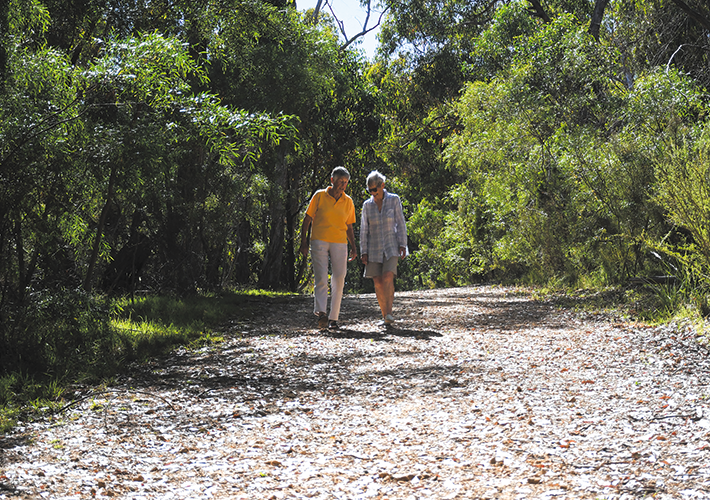More than 180 years have passed since the courageous Prussian Lutheran women made the long and arduous journey on foot from Hahndorf to Adelaide, winding through bushland, over creeks and past ghostly gums.
World wars have since been fought and the motor car has been invented, but the legacy of the German town’s pioneer women remained as centuries rolled by.
The 26km-long Pioneer Women’s Trail is not just a path weaving past historic homes and through native bushland.
It’s a reminder of the hundreds of women who have walked the undulating terrain in the hope of building a better life.
The trail’s existence can be traced back to 1839, when the European women carried up to 22kg of fresh produce from Hahndorf to sell in Adelaide, often undertaking the six-hour return journey barefoot or wearing wooden clogs.
But for millennia those same tracks – starting from Verdun and winding through Bridgewater and Mt George Conservation Park before descending to Beaumont – were used by Kaurna, Ngarrindjeri and Peramangk people trading and gathering for ceremonies.
For the last 49 years, a group of dedicated history enthusiasts have made it their mission to honour the legacy of the pioneer women by retracing their footsteps and reinstating the track.
Hahndorf resident Lyndell Davidge has been a member of the Hahndorf Branch of the National Trust of SA since the group began in the 1970s and has long been captivated by the adventures of the European women.



“What I find intriguing about European history and pioneering is that we often think about what the men accomplished and how they contributed to the economy and growth of the town, but the women are a bit of a footnote in history,” she says.
“These are people who left Europe and came to the other side of the world with really no idea what they were coming to, but they had enough faith to believe that they would be successful, and they made a go of it.”
The women and girls would set out on their journey in the middle of the night, singing Lutheran hymns as they made the rough trek carrying baskets of fresh fruit and vegetables, eggs, bacon, cream and butter on their shoulders. Carrying big sticks to defend themselves from bushrangers and the infamous Tiersman – men who cut timber in the area – they would trudge home carrying supplies of tobacco, cloth, sugar, tea and, supposedly, two bricks each to help build Hahndorf’s Lutheran church.
The women and girls would set out on their journey in the middle of the night … carrying baskets of fresh fruit and vegetables, eggs, bacon, cream and butter on their shoulders.
References to the journeys of these women went relatively undiscovered until the late 1970s when the trail was unearthed and a small group from Hahndorf walked to Beaumont House in six hours. Among the walkers was Lyndell.
“We did that first walk in ’79 just as a small group testing out the trail,” she says.
“It was hard to imagine doing it when all you had in front of you was a little mud map and the path.
“I think it would have been daunting.
“These women were setting up a new town and they wanted to be successful.
“It was a whole new life for them.
“They needed to earn some money to buy the things they needed and repay the debts they had.”
A year later in 1980 a public walk was organised to mark the Silver Jubilee of the National Trust.
About 150 people left Hahndorf Main Street and by the time they reached Eagle on the Hill that number had swollen to 300.
The trail’s popularity among walkers, runners, cyclists, history buffs and community groups has continued to grow, with a walk held annually to celebrate the legacy of the pioneer women.
Hundreds of people take part in the journey on foot from Hahndorf to Beaumont House, building new levels of admiration for the brave and tireless women and a deepening respect for the area’s Traditional Owners.
An excerpt from The Manning Index of South Australian History references the newcomers following the example of the Kaurna, Ngarrindjeri and Peramangk people who had walked the route before them by enjoying baked snakes and lizards when hungry.
The Hahndorf Branch of the National Trust acknowledges the Traditional Owners’ connection to the land and is now seeking to recognise the area’s Aboriginal heritage through a series of interpretive signs along the route. The group is working with the Burnside, Adelaide Hills and Mt Barker councils as well as First Nations people to install signs featuring maps, images and First Nations stories.
When completed, four trailhead signs and at least ten storyboard signs will tell inspiring stories of First Nations people and the Hahndorf pioneers.
Over the years way markers have been installed along the trail to direct walkers. Branch chairperson Annette Humphries says the project aims to give a stronger recognition to the area’s Traditional Owners.
“Up until recently, as has been the case with largely colonial history, the origin of the trail has been pretty much ignored,” she says.
“It has certainly been acknowledged for many years, but we believe the Aboriginal use of the trail is as important as the pioneer women’s use of the trail.”
The 2024 Pioneer Women’s Trail Walk will take place on Sunday, May 19, 2024.




